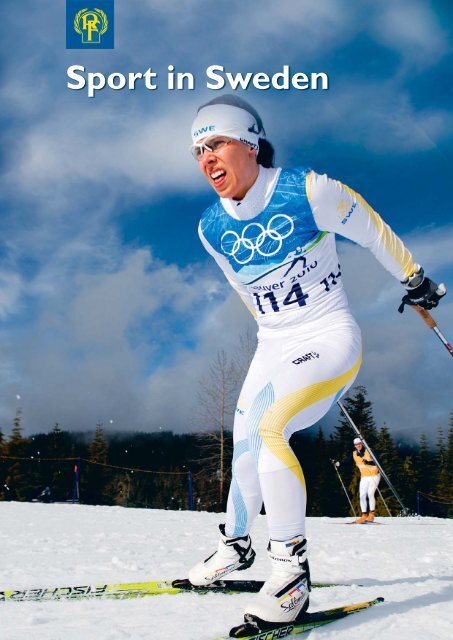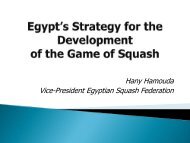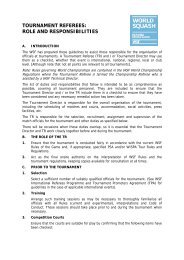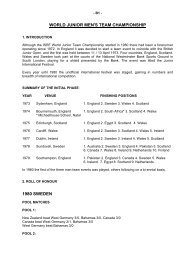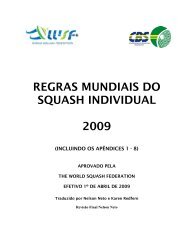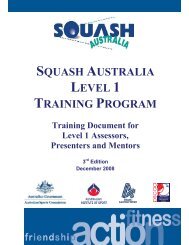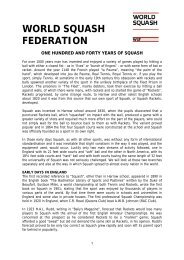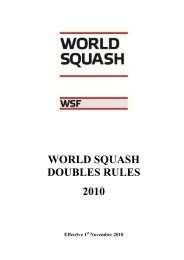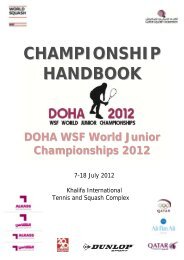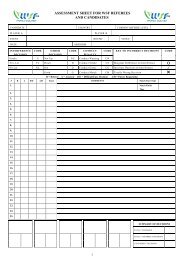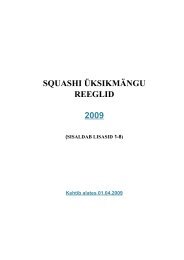Swedish Sports - World Squash Federation
Swedish Sports - World Squash Federation
Swedish Sports - World Squash Federation
You also want an ePaper? Increase the reach of your titles
YUMPU automatically turns print PDFs into web optimized ePapers that Google loves.
Sport in Sweden
Sport inSwedenThe <strong>Swedish</strong> <strong>Sports</strong> Confederationpaves the way for <strong>Swedish</strong> sportWhat is a voluntary, popular movement?Which organizations qualify for membership ofthe <strong>Swedish</strong> <strong>Sports</strong> Confederation? How doesthe democratic process function in <strong>Swedish</strong>sport? What is SISU – <strong>Swedish</strong> <strong>Sports</strong> Education.What has made a tiny country like Swedenso successful in sport?These are just some of the questions thatpeople ask about the <strong>Swedish</strong> <strong>Sports</strong> Confederationwhich represents much the largestvoluntary organization in Sweden. This bookletis intended to provide answers to all of thesequestions and to give the reader a real understandingof the <strong>Swedish</strong> sports movement.The <strong>Swedish</strong> <strong>Sports</strong> Confederation pavesthe way for <strong>Swedish</strong> sport and SISU - <strong>Swedish</strong><strong>Sports</strong> Education is the organization that ischarged with developing it.Further information is available at:www.rf.se.Basic statistics of <strong>Swedish</strong> sport Contents STOCKHOLM FEBRUARY 20122
Sweden –a sportingnationSweden is part of the Scandinavian peninsularIn terms of population it ranks as one of thesmallest European countries.Close to 9 million people are spread over450 000 km – a population of about 20 peopleper square kilometre.The northernmost part of Sweden is situatedabove the polar circle while the most southerlypart lies in the temperate continental climaticzone. There can be snow and ideal skiingconditions in the north while people are sailingin the south. The distance between the northernand southern extremes of Sweden is 1 500 km,the same distance that separates Copenhagenand Rome. Most Swedes live in the southernand central parts of the country.Unique public access tothe countrysideThe <strong>Swedish</strong> countryside is open to everybodyunder the ”Right of Common Access”, a unique<strong>Swedish</strong> right which allows everyone to moveto swim in and boat on lakes, rivers and otheropen water.Swedes spend a lot of time in the outdoors,making constant use of the countryside forsports such as orienteering, sailing, canoeingand skiing. Being so used to outdoor activitiesmeans that the Swedes have a built-in appreciationof and respect for nature and the environment.Swedes on the moveIn relation to its geography and population,Sweden is one of the world’s most sportingnations. Almost half of Sweden’s seven millioninhabitants between the ages of 7 and 70 are4
members of a sports club – as active competi-Some two million of these are active in sports.to belong to the elite; that is, they compete atnational championship level.Sport has an even more dominant positionamong youngsters. More than two out of everythree boys and every other girl between theages of 7 and 15 belong to a sports club. Thesport-for-all. There are some 20 000 sportsclubs in towns and villages throughout Sweden.12 000 of these organize sports för children andyoung people.Voluntary societies play a major role in <strong>Swedish</strong>life. Nowhere else in the world is the ratioof societies and clubs to the population so high.The right to participate in clubs and societiesis guaranteed by the <strong>Swedish</strong> constitution.This gives everyone the right to found a clubor society with a particular aim without outsideinterference.Clubs are the foundation of the sportsmovement in Sweden. The development of<strong>Swedish</strong> sport is the result of the initiatives ofinnumerable people. The clubs were created bypeople who needed to collaborate and organizethemselves in order to practise their chosensport. Thus sport in Sweden was developed atgrass-roots level by the participants themselves.This is fundamental to what we in Sweden terma popular movement.The <strong>Swedish</strong> sporting miracleThe minute country of Sweden has contributedinnumerable stars to world sport. IngemarJohansson, Gert Fredriksson, Nils Liedholm,Björn Borg, Ingemar Stenmark, Anders Gärderud,Gunde Svan, Pernilla Wiberg and Jan-OveWaldner have for ever carved their names intothe <strong>Swedish</strong> soul. In recent years stars suchas Peter Forsberg, Annika Sörenstam, KajsaBergqvist, Stefan Holm, Anja Pärson, NiklasLidström, Henrik Larsson and Zlatan Ibrahimo-in international arenas.Characteristics of apopular movement 5
Persons aged 16-84who are membersand/or in positionsof responsibility<strong>Sports</strong> clubCultural societyOutdoor life clubPolitical partyParents associationEnvironmental organizationSpectators aged7-70 years FootballIce hockeyAutomobile sportsFloorballHandballTrack and fieldEquestrianBandySkiingCross-country skiingMotorcycle sportsSwimmingGolfTennisDanceReligious body0 0,5 1,0 1,5 2,0 2,5 miljMembersNumber of positions of responsibilitySource: Statistics Sweden 2010How can it be that a very small country likeSweden, with a population of only nine million,is such an important sporting nation? Thisis a question that many people ask, not least inother countries. Proof of this claim can be seenin the fact that Sweden occupies seventh placein the Olympic medal table. Added to this arenumerous successes in “<strong>Swedish</strong>” sports thatare not represented at the Olympics or that haveonly recently been included: tennis, oriente-a number of explanations:External factors:ralcatastrophes, raw materials, energy sources,well-developed educational system and goodinfrastructure).authorities and sport.ciansand receives generous grants and investmentcapital for sports facilities.0 500 000 1 000 000 1 500 000 2 000 000Internal factors:sport’s greatest resources, the extensive voluntarycontributions, and having elite sports andsport-for-all under the same umbrella.education, mainly through the national sportssecondary schools.mesfor children and young people.own adult-education organization SISU - <strong>Swedish</strong><strong>Sports</strong> Education.logy.In Sweden we have a united sports movementthat works towards the same vision based onshared by all the associations and clubs in bothsport-for-all and elite sports. We are equallyconcerned to promote sport-for-all and elitesports in that both aspects of sport stimulateeach other and help to develop the sports movement.Our sporting stars are important as entertainers,but even more so for the way in whichthey inspire young and old alike. Each weeksome child is curious about trying their handat what the stars have shown them, whetherit is Zlatan scoring a goal or Charlotte Kallawinning in cross-country skiing. Our great internationalsuccesses lead to thousands of newpeople taking up sportsThe social value of elite sportsThe great social value of elite sport is seldomtaken into account. Our sporting stars inspirecoming generations to take up sports and stimu-provide us with entertainment and excitementin our daily lives.Every culture in every age has its heroes. Ourown heroes are star athletes. There is real socialvalue in our leaving the comfort of our homesand going to watch a match or competitivesports. On the terraces we become part of theevent and can feel like experts. We rejoice withthousands of other people. When things aregoing badly we can complain in unison. Thenwe discuss the match or competition duringcoffee breaks or among our friends. A matchor competition is never a foregone conclusion.The uncertainty generates excitement anddrama. Life on the terraces with other supportersis unconstrained and often results in socialnetworks that mean a lot to individuals.Source: Statistics Sweden 20106
Sixten Jernberg Gunnar Nordahl Gert FredrikssonIngemar Johansson Toini Gustafsson Sven TumbaUlrika KnapeAnders GärderudTomas GustafsonBjörn BorgIngemar Stenmark Gunde Svan Agneta Andersson7
Pernilla WibergJan-Ove WaldnerTony RickardssonPeter ForsbergHenrik LarssonNiklas LidströmCarolina KlüftAnnika SörenstamKajsa BergqvistStefan HolmAnja PärsonCharlotte KallaTherese AlshammarZlatan IbrahimovicAnette Norberg8
The ideaof <strong>Swedish</strong>sportThe <strong>Swedish</strong> sports movement adheres to theUN’s Universal Declaration of Human Rights,the UN Convention on the Rights of the Childand the Convention on the Rights of Personswith Disabilities.“Sport wills - aims and guidelines for thesports movement” is the name of the policyprogramme for <strong>Swedish</strong> sport. It represents acommon system of values for the entire sportsmovement and provides guidelines for theorganization of sports activities in federationsand clubs.Sport is physical activity that we undertakewith a view to performing better, having fun orfeeling good.Sport consists of training and fun, competitionand display.We categorize sport according to age andlevel of ambition. Children’s sport is normallyconsidered to be up to the age of twelve. Youthsports are normally up to the age of twenty.Adult sports are for those over twenty.In children’s sport we play and let childrenlearn different sports. The child’s all-roundsporting development is the norm for children’ssport. Competition is an aspect of the game andmust always be conducted on the children’sown terms.In youth and adult sports we distinguishbetween competitive, performance sports andThe idea of sport: We want to organize sportat all levels so that it develops people positivelyboth physically and mentally, socially andculturally.Sport is to be organized so that it promotes:9
Vision and values of thesports movementWe are a united sports movement workingtowards the same vision based on the samevalues, namely “<strong>Swedish</strong> sport – world best”;a vision that is rooted in all our associationsand clubs, both those involved in sport-for-alland elite clubs. We value sport-for-all clubsand elite clubs equally since they are equallyimportant in motivating and developing sport.The 2009 General Assembly of the <strong>Swedish</strong><strong>Sports</strong> Confederation adopted the vision<strong>Swedish</strong> sport – world best, stipulating that thevalue system should primarily accord with:10
OrganizationThe <strong>Swedish</strong> <strong>Sports</strong> Confederation69 Special <strong>Sports</strong><strong>Federation</strong>s21 District<strong>Federation</strong>s20 000Clubs1 000 Special <strong>Sports</strong>District <strong>Federation</strong>s3,4 million membersA democratic movementThe <strong>Swedish</strong> sports movement is part of ourcultural heritage and an important aspect of ournational identity. Thanks to the sports movement,millions of <strong>Swedish</strong> citizens have learntdemocratic procedures, respect for rules andfair play, have developed their leadership skillsand improved their knowledge of dietary issues,physical exercise, health and wellbeing.Sport is organized differently in differentparts of the world. Our organizational traditionis generally known as the “Scandinavian” or“Nordic” model. This means that sport is organizedas an independent voluntary movement.A long experience of collaboration with centralgovernment and local authorities has led to thesports movement being entrusted with the taskof organizing sport in Sweden with the help ofauthorities.Local clubs are the foundation of all organizedsport. And so it is the primary task of supportorganizations in the sports movement tocreate the essential conditions for a successfulclub. Matters to be dealt with include grants,tax regulations, sports grounds and facilities,development of club democracy and leadershiptraining. The executive committee is, apartfrom the General Assembly, the most importantorgan of the local sports club.Democratic structureA club is “owned” by its members; it is themembers who determine, at the club’s annualgeneral meeting, what the club is to do and howmeeting there are reports from the executiveabout the previous year’s activities and abouthow the executive has discharged its duties.The annual general meeting concludes with themembers deciding who is to be entrusted withrunning the club until the next annual meeting.The basic principle is that each member has onevote.acquainted with the formalities of democraticgovernment when someone has demanded thata vote be taken at an annual general meeting oftheir club. As a member of a voluntary, non-in the democratic process. And the <strong>Swedish</strong><strong>Sports</strong> Confederation only admits democraticned by their statutes which require democraticforms such as annual general meetings, executivecommittees, nominating committees, rulesgoverning motions (proposals from members)and so on. At a time when many other voluntaryorganizations are declining in membership,the role of the sports movement in fosteringdemocratic ideals is all the more important.11
Number of womenand men inSF’s executivecommitteesYounger than 3030 - 45 years46 - 60 years160Men140Women120100806040200Over 60 yearsSource: Statistics Sweden 2010The path to gender equalityApproximately 40 per cent of people active insports in Sweden are women. Although muchhas been done to promote equality between thesexes, women constitute only 30 per cent of theexecutives of special sports federations.In 1995 the General Assembly of the <strong>Swedish</strong><strong>Sports</strong> Confederation decided that allorgans of the <strong>Swedish</strong> <strong>Sports</strong> Confederationand district federations shall consist of equalnumbers of women and men. In 2005 Ka-female President of the <strong>Swedish</strong> <strong>Sports</strong> Confederation.12
The leading leadership schoolThe <strong>Swedish</strong> sports model is entirely dependenton the voluntary support of local leaders as wellsystem.It is estimated that about 640 000 Swedeshave one or more positions as leaders in theThey are to be found on executive committeesthe essential conditions that enable the <strong>Swedish</strong>sports model to function. In their work theytheir leadership skills.in sport attend courses with the intention ofbecoming better leaders and developing theirclubs. Most of the courses are run by the sportsmovement’s own adult education organizationSISU – <strong>Swedish</strong> <strong>Sports</strong> Education. Studiespromoted by the <strong>Swedish</strong> <strong>Sports</strong> Confederationindicate that what people learn in leadershiptraining courses is highly valued both by sportsleaders and employers. No other <strong>Swedish</strong> organizationhas such a comprehensive leadershiptrainingprogramme as the sports movement.Personal developmentFuture advantagesLeadership trainingSupport from the organizationAppreciated by othersFinancial returnGives statusOwn friends are leaders0 20 40 60 80 100%Why do peoplewant to be orbecome sportsleaders?Source: Sifo13
Diversity as a unifying forceThe ten leadingcompetitive sportsNumber of activeparticipants (7-70)There is remarkable diversity in the <strong>Swedish</strong>sporting family. There are clubs that unite thoselone wolves who, in rain and sleet, cover mileafter mile of lonely roads, testing their own absolutelimits. There are clubs that pay homageto team sports and collective ideas in whichcollaboration between individuals and the sumFootballGymnasticsGolfFloorballTrack and fieldSport shootingIce hockeyEquestrianHandballMartial arts0 100 000 200 000 300 000 400 000 500 000 600 000 700 000(Thousands) Source: <strong>Swedish</strong> <strong>Sports</strong> Confederationof individual skills determine the result. Thereis room for those who want to become stronger,improve their stamina, and develop their coordination,technique or tactics. But sportsalso form an important arena for social contactsin which old and young, able-bodied anddisabled, men and women, native Swedes andfanatically serious elite sportsmen and womencan meet. It does not matter where you live orwhat the climate is like. The <strong>Swedish</strong> sportsmovement offers something for everyone whowants to be a part of it, irrespective of whereone lives.The <strong>Swedish</strong> <strong>Sports</strong> Confederation consistsof 69 special sports federations. They can beso-called multisport federations covering a largenumber of different sports, for example the<strong>Swedish</strong> <strong>Sports</strong> Organization for the Disabled.14
Sport promotes integrationSome 20 per cent of Swedes today are offoreign origin.Finding one’s feet in a new country with adifferent language and culture is no easy taskwhether for an adult or a child. But the languageof sport is universal: a ball bounces equallywell in <strong>Swedish</strong> as in Serbian and one can jumpjust as far in Swahili as in <strong>Swedish</strong>.A study by the <strong>Swedish</strong> <strong>Sports</strong> Confederationin 2010 found that sport is by far the mostpopular leisure activity for youngsters of both<strong>Swedish</strong> and foreign backgrounds. The studyalso found that boys of foreign origin rate sporteven more highly than their <strong>Swedish</strong> counterparts.Sport is also considered important bygirls of foreign origin, but the sports movementneeds to do even more to attract participationfrom these girls.Sport builds bridges over ethnic divides and,given its wide-ranging activities, it is the mostimportant social arena for integration. The issueis important to the sports movement; but itis even more important to the future of Sweden.Requirements for membership ofSweden’s sports familyElection to membership of the <strong>Swedish</strong> <strong>Sports</strong>Confederation requires nomination and approvalby the General Assembly of the <strong>Swedish</strong><strong>Sports</strong> Confederation. Certain formal requirementsmust be met. The association must be/have:and ideology of the voluntary sports movementother sport within the <strong>Swedish</strong> <strong>Sports</strong> Confederationmembersof 69) not only belong to the <strong>Swedish</strong> <strong>Sports</strong>Confederation; if their sport is featured at theOlympic Games they are also members of the<strong>Swedish</strong> Olympic Committee which administers<strong>Swedish</strong> participation at the Olympicportvia the <strong>Swedish</strong> <strong>Sports</strong> Confederation’s<strong>Swedish</strong> Olympic Committee is further enhancedby commercial sponsorship in view of themarketing value of the games.Read more about the <strong>Swedish</strong> OlympicCommittee on page 18.Members of The <strong>Swedish</strong> <strong>Sports</strong> ConfederationFounded Entrance inthe SCC 15
Co-ordinating andpromoting <strong>Swedish</strong> sportThe national organizationof <strong>Swedish</strong> sportThe <strong>Swedish</strong> <strong>Sports</strong> Confederation is anumbrella organization consisting of 69 specialsports federations and 21 district sports federations.Many people believe that the <strong>Swedish</strong> <strong>Sports</strong>Confederation controls its member associations.In fact, the role of the <strong>Swedish</strong> <strong>Sports</strong> Confederationis the reverse. It is to execute the policyagreed by the member associations at the GeneralAssembly. The fundamental principle is thateach special sports federation is responsible forits own sport and any problems in that sport aredealt with by the sport’s own federation. Buteach member association is also responsible forthe entire organization.Legally, the <strong>Swedish</strong> <strong>Sports</strong> Confederation isa society that is regulated by the charter agreedby its members. This form of an assembly ofindependent organizations is often termed afederation.The main task for the <strong>Swedish</strong> <strong>Sports</strong> Confederationis to work as effectively as possible forthe member federations so that these can devotethe maximum time to sport itself. There are forexample many tasks of a more general characterthat are either too complex or too time-16
consuming for the special sports federationsto deal with themselves. The <strong>Swedish</strong> <strong>Sports</strong>Confederation relieves the sports movement ofunnecessary administrative tasks and negotiatesadvantageous contracts, thus giving sport moremoney for its activities.The <strong>Swedish</strong> <strong>Sports</strong> Confederation is alsoactive in areas in which individual federationscannot allocate resources, principally in mattersand overriding collaboration.One of the most important tasks is to representthe whole <strong>Swedish</strong> sports movement incontacts with the authorities, politicians etc.High priority is given to employing the fullforce of a united popular movement vis-à-vispoliticians..Strategic leadershipThe <strong>Swedish</strong> <strong>Sports</strong> Confederation is a powerfulorgan of opinion in the service of <strong>Swedish</strong>sport, continually clarifying the responsibilitythat sport assumes and the positive values thatthe popular movement represents. The <strong>Swedish</strong><strong>Sports</strong> Confederation is a regular consultativepartner of the government as well as collaboratingwith government departments andministries.One of the <strong>Swedish</strong> <strong>Sports</strong> Confederation’soverriding tasks is that of providing strategicleadership for <strong>Swedish</strong> sport pertaining tocations.The <strong>Swedish</strong> <strong>Sports</strong> Confederation alsoinitiates and supports interdisciplinary researchin medicine, physiology, sociology, technologyand the behavioural sciences.It is the <strong>Swedish</strong> <strong>Sports</strong> Confederation thatdefends the legitimacy of sport and reports onthe current state of sport, illuminating its extentand importance.The General Assembly setsthe courseThe special sports federations are representedby 200 delegates at the General Assemblywhich is the sports movement’s supremedecision-making body.Besides electing members to the ExecutiveCommittee, the assembly determines the directionof sport for the ensuing two years. Delegatesconsider various motions and also decidewhether to allow new sports to join the family.well as members of the Doping Commission,the Supreme <strong>Sports</strong> Tribunal and an ElectoralCommittee to propose candidates for the nextGeneral Assembly.The Executive Committee governsThe Executive Committee of the <strong>Swedish</strong><strong>Sports</strong> Confederation, which governs operationsbetween general assemblies, consists oftwelve members including the President. In2005 Karin Mattsson Weijber was elected asConfederation.Two organizational principlesThroughout the country, clubs are organizedaccording to two principles: one geographicaland one linked to the sport. The geographicalorganization takes the form of district sportsfederations while particular sports are organizedin special sports district federations andspecial sports federations. At the national levelthe unifying organization is the <strong>Swedish</strong> <strong>Sports</strong>Confederation.The Confederation’s rolecan be summarized as: 17
District sports federations<strong>Swedish</strong> sport is divided into 21 district sportsfederations. Within their respective areas thesefederations work with much the same mattersas the <strong>Swedish</strong> <strong>Sports</strong> Confederation.Special sports district federationsWithin their districts the special sports districtfederations co-ordinate all the activities of aparticular sport, especially competitions andtalent development for youth sports and lowerdivisions.The <strong>Swedish</strong> Supreme<strong>Sports</strong> TribunalThe sports movement has its own ”supremecourt” called the <strong>Swedish</strong> Supreme <strong>Sports</strong> Tribunal.The tribunal deals with appeals againstlegal decisions handed down by the specialsports federations.The <strong>Swedish</strong> Olympic CommitteeThe supreme authority of <strong>Swedish</strong> sports in allOlympic matters is the<strong>Swedish</strong> Olympic Committee,SOC. It comprises35 national Olympicsports federations as wellas 12 federations of sportsrecognized by the InternationalOlympic Committee.The Executive Board is elected for termsof four years and consists of eleven members18
Support for national teams helps to makethese more competitive and to prepare athletesmance.The focused support goes to individualathletes and teams that are aiming for the highestlevels of sport with championship medalsin sight. The general support brings with itaccess to resource people, skills development,and so on.Anti-doping programmeDoping is unacceptable; a form of cheatingthat damages the soul and credibility of sportas well as threatening the lives and health ofathletes.By developing an active anti-doping programmeat all levels of sport the <strong>Swedish</strong><strong>Sports</strong> Confederation intends to ensure thatall athletes enjoy the right to participate andcompete in sport free from doping.The complex, which is owned by the <strong>Swedish</strong><strong>Sports</strong> Confederation, is beautifully situatedon the waterfront north of Stockholm andcomprises three areas:Bosön Top Sport Centre: The National SportComplex at Bosön is home to the <strong>Swedish</strong>sports movement’s institute for elite support.Bosön Education Centre offers those interestedin sport unique opportunities forcombining sport with studies. It also providesprogrammes for trainers, coaches, referees andother leaders.Bosön Conference Centre arranges all kindsof gatherings and events.Sport and education foryoung peopleThere are upper secondary schools making itpossible to combine education and elite sports.These pupils follow a standard curriculum buthave opportunities for training during the day.A united programme for elite sports<strong>Swedish</strong> sport is developing vigorously.Starting in the autumn of 2009, all support forelite sports is channelled through the <strong>Swedish</strong><strong>Sports</strong> Confederation. There are three aspectsto the elite programme:as training, sports psychology, nutrition andmedicine).20
The anti-doping programme within the <strong>Swedish</strong>sports movement is led and co-ordinatedby the <strong>Swedish</strong> <strong>Sports</strong> Confederation and itsDoping Commission. The most important toolsof the programme are doping tests together withinformation and education. The tests not onlyreveal doping where it occurs but they also giveathletes the welcome opportunity to show thatthey are ”clean”.Anti-doping operations have become increasinglyinternationalized in recent times.With the foundation of the <strong>World</strong> Anti-Dopingments from all continents are now working sideby side with sport with a view to harmonizingand making more effective the struggle againstdoping. Sweden is actively engaged in thisdevelopment and has played a prominent role inpromoting doping-free sport.Lift for SportThe <strong>Swedish</strong> <strong>Sports</strong> Confederation has a specialprogramme, “Lift for Sport” [Idrottslyftet],which is intended to get children to try outsports activities as well as encouraging olderyoungsters to continue with sports bysporting environments“Lift for sport” has been promoted by morethan 10 000 clubs and attracted more than800 000 participants with equal numbers ofwomen and men.21
International collaborationInternational exchange is important to <strong>Swedish</strong>sport. The <strong>Swedish</strong> <strong>Sports</strong> Confederation worksintensively with advancing Sweden’s positionand spread understanding of the ”Nordic model”with sport organized as a popular voluntarymovement. For this the <strong>Swedish</strong> <strong>Sports</strong>Confederation supports the special sportsfederations in their international activities.Around 300 <strong>Swedish</strong> sports leaders havemore than 450 positions on executives or committeesof different international sports organizations.The following policy on international rela-22
tions was adopted by the General Assembly1991:-----------<strong>Swedish</strong> sport and theEuropean Union-operational areas:Seeking international influence-*EOC: European Olympic Committees,**ANOC: Associations of National OlympicCommittees.23
Financial andother resourcesSome figures froman average club Economy in anaverage club<strong>Sports</strong> lift (goverment grants)Government grantsLocal grantsMembership feesTraining feesEventsAds, sponsorshipLotteriesSalesRemaining0 5 10 15 20A common illusion is that sponsors keep thewheels of <strong>Swedish</strong> sport spinning. This isnot the case. Though sponsors do contribute,particularly to arena sports which create mediainterest, sponsorship hardly accounts for morethan 172, 2 millions Euros, which representssome 15-20 per cent of total funding for sportif one discounts the contribution of voluntaryleaders.For clubs, local sponsoring is common and itrepresents an average of about nine per cent ofincome. By far the largest contribution comesin the form of voluntary assistance, which correspondsto about 70 000 fulltime jobs.The municipalities of Sweden are responsiblefor the greater share of public support for thesports movement. A study by the <strong>Swedish</strong><strong>Sports</strong> Confederation shows that subsidiesamounted to 250 million Euros, grants to clubsto 109 million Euros and investments in sportsfacilities to 360 million Euros in 2011.Government funding amounts to about 183,4million Euros annually. This grant is administeredby the <strong>Swedish</strong> <strong>Sports</strong> Confederation. Morethan 75 per cent of the grant goes to the specialsports federations or direct to clubs, based ongoes to central administration.Sport in Sweden also receives more than9,5 million Euros from the county authorities.Most of this money goes directly to the specialsports district federations via the district sportsfederations.Another widely held myth is that sport – particularlyelite sport – costs society a great dealof money. The truth is that the sports movementalso pays a great deal of money into the publicpurse in the form of taxes and tariffs. Majorsporting events draw large numbers of visitorseconomy.The Gothia Cup is one of the world’s largestfootball tournaments. It attracts some 50 000players, leaders and supporters from all cornersof the globe. In 2009 the tournament turnedover some 5,5 million Euros which gave abonus to the tax authorities of about 12 millionEuros.race) attracts some 50 000 elite skiers, amateursand spectators. In the course of two or threeweeks they spend about 2 million Euros.Creative clubs<strong>Sports</strong> clubs show great creativity and commitmentto fundraising with everything from tra-24
ditional lotteries to sales of domestic products.But the largest single source of income forsports clubs consists of the membership feesand charges.Facilities run by clubsThe <strong>Swedish</strong> sports movement relies on theactive participation of hundreds of thousandsof leaders and a political expectation that localauthorities should provide sports facilities forschool children, club members and other localinhabitants.At a time when the public sector is expectedto make savings many local authorities do notconsider themselves able to afford, for example,to run sports premises. For this reasonclubs have increasingly reached agreementswith local authorities to take over managementof premises. Half of the country’s sports premisesare now owned or run by sports clubs.25
The <strong>Swedish</strong> model leads tomanifold returnsOur organizational model for sport as a democraticand independent popular movement isunique to Scandinavia. It builds on the voluntarycontributions of hundreds of thousandsof leaders together with a consensus that localauthorities should help to create positive conditionsfor sport.Increasing attention is now being given tothe role of sport in the social economy. Thanksto its democratic and voluntary structure, thesports movement is uniquely placed to contributeto the development of society. It comesnaturally to many sports organizations to meetthe needs of society by taking responsibilityfor other activities than purely sporting ones.<strong>Sports</strong> clubs give the people of their localitygood service, not just through their coresporting activities but by organizing swimminglessons, renting out holiday cabins, maintainingski trails, renting out canoes, preparing skatingrinks and much else. Much of this is alsoincome and creates jobs.Simply put, sport makes manifold returns:partly in actual money but, above all, in wellbeing,in improved health, in a sense of community,entertainment, joy and meaningful activitiesfor millions of Swedes.26
BNP per head of population: Currency: Labour market: Standard working time: Facts about Sweden(October 2011)Area: Climate: Population: Inhabitants per km2: Birth rate: Capital: Ethnicity: Language: National minority languages: Literacy: Immigration: Religion: Health care and social welfare National health insurance: Parent allowance: Child allowance: Child care: Pensions system: School system: Higher education: Life expectancy: Constitution: Universal suffrage: Foreign policy and defence: 27


